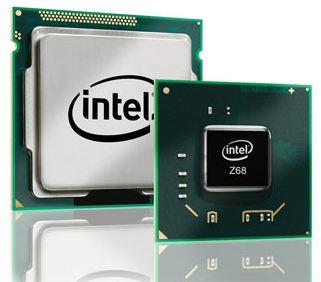New Intel Core chips
Intel launched a new range of processors at the start of 2011. Formerly known by the codename Sandy Bridge, the second-generation Core chips integrate both the CPU and GPU on to one physical processor that slots into a motherboard.
These new chips, suitable for laptop and desktop PCs, are available in a multitude of speed-grades, caches and cores. Making it easier to understand for the consumer, Intel splits them into three families that loosely define the performance - and, therefore cost - of the Core chips. At the budget end there's Core i3, followed by mainstream Core i5, and topped off by the enthusiast-grade Core i7.
P67 and H67 - not quite right
New motherboard chipsets have also been released to support these 2011 Core processors. On the desktop side, the P67 and H67 chipsets launched at the same time. While the P67 chipset enables the user to build a high-performance PC by including motherboard slots for multiple graphics cards along with BIOSes geared towards overclocking the CPU, Intel doesn't enable video outputs for the GPU part of the Core chip on this core-logic. Rather, the user needs to use a dedicated video card, thereby missing out on the QuickSync feature of the GPU, used for speeding-up video processing.
H67 chipset-based motherboards, on the other hand, enable QuickSync and an array of video outputs - HDMI, DisplayPort, DVI - from the Core processor, enabling customers to build a relatively inexpensive, power-efficient PC, though there's little support for overclocking the CPU or using multi-GPU graphics from NVIDIA or AMD.
A new core-logic was needed that liberally took the best bits out of H67 and P67. On May 11, 2011, Intel released Z68, with the aim of being that can-do-it-all chipset.
Z68 - best of both worlds
Z68 motherboards enable all of the features of P67 - overclocking, multi-GPU support, et al - while, on most retail boards, letting you use the Core chip's video outputs in the same way that H67 does. What's more, Z68 offers BIOS options that let the user manually increase the speed of the integrated graphics - a first for any second-generation Core-supporting chipset.
However, like H67, this new core-logic doesn't permit one to switch between a discrete (add-in) GPU's output and the Core chip's video output, to advantage of the QuickSync feature. Companies such as LucidLogix have released workarounds, though, and its Virtu software is available on a number of ASUS and MSI Z68-based motherboards.
Z68's ace in the pack: SRT
Yet the Z68 has a trick up its sleeve that the extant P67 and H67 cannot match. It's a storage-based feature known as Intel Smart Response Technology (SRT), and it works by using the benefits of a solid-state drive (SSD) - super-fast access, high sequential speeds - and mating them with a regular mechanical hard-drive, to speed-up frequently-used applications.
Drilling down, a mechanical hard-drive has the intrinsic benefit of being relatively cheap and capacious: a 1.5TB model can be purchased for under £50. However, the nature of a mechanical hard-drive, where physical heads need to move across the drive to access data, means that loading applications isn't lightning-quick. An SSD, with no moving parts, has fundamentally quicker access but is priced much higher.
With a regular hard-drive and small-capacity SSD installed in the Z68 system, SRT enables the user to merge the two drives together, creating a hybrid of sorts. This hybrid storage, which appears to the operating system as a single drive, uses the SSD as a large cache. This means that storage performance jumps when an application is run multiple times, for it's primarily cached on the SSD.
Any SSD can be paired with a mechanical drive, which makes obvious sense, though the proviso is that its capacity must be limited to 64GB. SRT can provide significant gains once the caching is done, but the current downward pricing pressure on 64GB SSDs - now available for £80 - means that a user can simply bypass SRT altogether and use the SSD as an operating system boot-drive and a store for most-used programs, with the spacious mechanical drive as merely storage. This approach, available on every chipset, diminishes the usefulness of SRT.
Z68 - still the best chipset for Core chips
In summary, Z68 takes all the best bits from the P67 and H67 chipsets and pulls them together. Specifically it ties the CPU overclocking potential of P67 with the chip's GPU goodness available via H67. On top of this it adds in GPU overclocking and some exclusive SSD caching in the form of Smart Response Technology (SRT).
Users who merely need a basic motherboard to run their new second-generation Core processor, either with a single dedicated graphics card or via on-chip video, should look at a vanilla H67 board, which retail from £70 and is presented in a range of form factors. The P67 chipset, meanwhile, is geared towards the user who needs finer control over voltages and speeds together with the ability to run more than one graphics card. Typically, P67 motherboards retail from £90.
Z68 boards retail from around £100 and, for now, represent the most-complete support for Intel's latest desktop processors.








